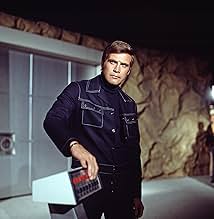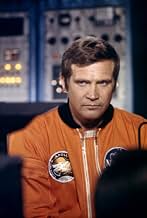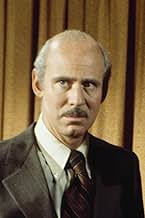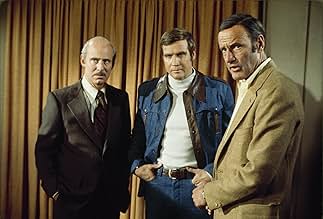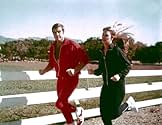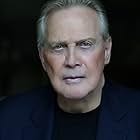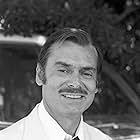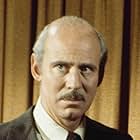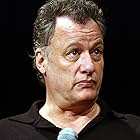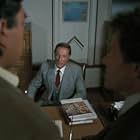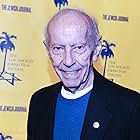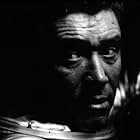Dopo che un pilota di velivoli sperimentali viene seriamente ferito in un incidente, i suoi arti ed organi vengono sostituiti con impianti cibernetici e diventa un agente segreto.Dopo che un pilota di velivoli sperimentali viene seriamente ferito in un incidente, i suoi arti ed organi vengono sostituiti con impianti cibernetici e diventa un agente segreto.Dopo che un pilota di velivoli sperimentali viene seriamente ferito in un incidente, i suoi arti ed organi vengono sostituiti con impianti cibernetici e diventa un agente segreto.
- Candidato a 2 Primetime Emmy
- 1 vittoria e 5 candidature totali
Sfoglia gli episodi
Trama
Lo sapevi?
- QuizThe characters of Oscar Goldman (Richard Anderson) and Rudy Wells (Martin E. Brooks) appeared on this series and its spin-off, La donna bionica (1976). When the spin-off moved to another network, this practice continued. This was the first time the same continuing characters appeared on two different television series broadcast on two different networks at the same time.
- BlooperAt the end of the title sequence, Steve Austin is running towards the camera while passing a line of trees. However the trees are also "moving" forwards with him. The audience should see the trees moving backwards relative to him.
- Citazioni
[Opening narration, version 1]
Harve Bennett: Steve Austin, astronaut. A man barely alive.
Oscar Goldman: We can rebuild him. We have the technology. We can make him better than he was. Better, stronger, faster.
- Versioni alternativeSeveral early episodes, now syndicated as two-part stories, were original broadcast as 90-minute TV movies. Most retain their original titles, except for the first two episodes of the series, "The Moon and the Desert," which were originally part of the original Six Million Dollar Man TV-movie. Several later two-hour episodes of the series have also been reedited into two-parters, such as "Lost Island."
- ConnessioniFeatured in Secret of Bigfoot (1979)
Recensione in evidenza
There is no question that The Six Million Dollar Man was as revolutionary a program in its prime as it is woefully overlooked today. Most of the great science fiction themes had been exhausted during the early Cold War era, when fears of alien invasions and nuclear holocaust were rampant. It was the horror genre, if anything, that enjoyed a resurgence in the 1970's, with such notable offerings as The Exorcist and Jaws, and television programs like Dark Shadows. By contrast, the 70's were lean years for sci-fi - the classic motifs of the 60's were dead, and successful 80's tech-shows like Knight Rider were still on the shelf.
But Col. Steve Austin virtually redefined the genre with his story of bionic implantation. His character was indisputably TV's first cybernetically enhanced human being of any significance. In fact, rarely did even the silver screen feature a cyborg in a major role before TSMDM debuted. After its long run at the top, Hollywood began churning out its subtle rip-offs, which spawned such diverse characters as "Bishop" in Alien, The Terminator, "Data" and the dreaded Borg from Star Trek TNG, and a host of mediocre Austin clones in Van Damme-style B-movies.
Further, TSMDM was competent in its own right. The show was a household name during its reign, and gave birth to the kind of merchandising mania - action figures, board games, etc. - more typical of a big-budget motion picture than a television series. There wasn't a young boy anywhere in North America who didn't mimic the Colonel's slow-motion antics in the schoolyard, and even parents inevitably ended up enjoying the program as much as their kids (name another show that can make that claim!).
The cast was well-chosen and usually convincing, with Majors' understated but charming persona leading the way. The special effects were acceptable for the time, if not particularly ground-breaking. Best of all, the episodes were reliably action-packed, well developed and truly imaginative in their diversity and execution. The program touched on alien visitors, military themes, espionage, romance, and never lost its sense of perspective or sheer fun.
My only complaint with TSMDM is that no station in my part of the world carries the show any longer. Amazingly, the Space Channel sees fit to broadcast garbage like Beauty and the Beast and Lexx, but turns its back on a genuine pioneer of the genre. It's confounding. Shows like this cannot be allowed to simply rot away in some vault. They must be preserved, just as legends in their time like Star Trek clearly have. I'd love for my children to share in the awe and excitement I felt when TSMDM was new and fresh, and, quite frankly, I wouldn't mind feeling like a kid again myself!
But Col. Steve Austin virtually redefined the genre with his story of bionic implantation. His character was indisputably TV's first cybernetically enhanced human being of any significance. In fact, rarely did even the silver screen feature a cyborg in a major role before TSMDM debuted. After its long run at the top, Hollywood began churning out its subtle rip-offs, which spawned such diverse characters as "Bishop" in Alien, The Terminator, "Data" and the dreaded Borg from Star Trek TNG, and a host of mediocre Austin clones in Van Damme-style B-movies.
Further, TSMDM was competent in its own right. The show was a household name during its reign, and gave birth to the kind of merchandising mania - action figures, board games, etc. - more typical of a big-budget motion picture than a television series. There wasn't a young boy anywhere in North America who didn't mimic the Colonel's slow-motion antics in the schoolyard, and even parents inevitably ended up enjoying the program as much as their kids (name another show that can make that claim!).
The cast was well-chosen and usually convincing, with Majors' understated but charming persona leading the way. The special effects were acceptable for the time, if not particularly ground-breaking. Best of all, the episodes were reliably action-packed, well developed and truly imaginative in their diversity and execution. The program touched on alien visitors, military themes, espionage, romance, and never lost its sense of perspective or sheer fun.
My only complaint with TSMDM is that no station in my part of the world carries the show any longer. Amazingly, the Space Channel sees fit to broadcast garbage like Beauty and the Beast and Lexx, but turns its back on a genuine pioneer of the genre. It's confounding. Shows like this cannot be allowed to simply rot away in some vault. They must be preserved, just as legends in their time like Star Trek clearly have. I'd love for my children to share in the awe and excitement I felt when TSMDM was new and fresh, and, quite frankly, I wouldn't mind feeling like a kid again myself!
- krunchy2001
- 24 ago 2001
- Permalink
I più visti
Accedi per valutare e creare un elenco di titoli salvati per ottenere consigli personalizzati
- How many seasons does The Six Million Dollar Man have?Powered by Alexa
Dettagli
- Tempo di esecuzione1 ora
- Mix di suoni
- Proporzioni
- 1.33 : 1
Contribuisci a questa pagina
Suggerisci una modifica o aggiungi i contenuti mancanti

Divario superiore
By what name was L'uomo da sei milioni di dollari (1974) officially released in India in English?
Rispondi



